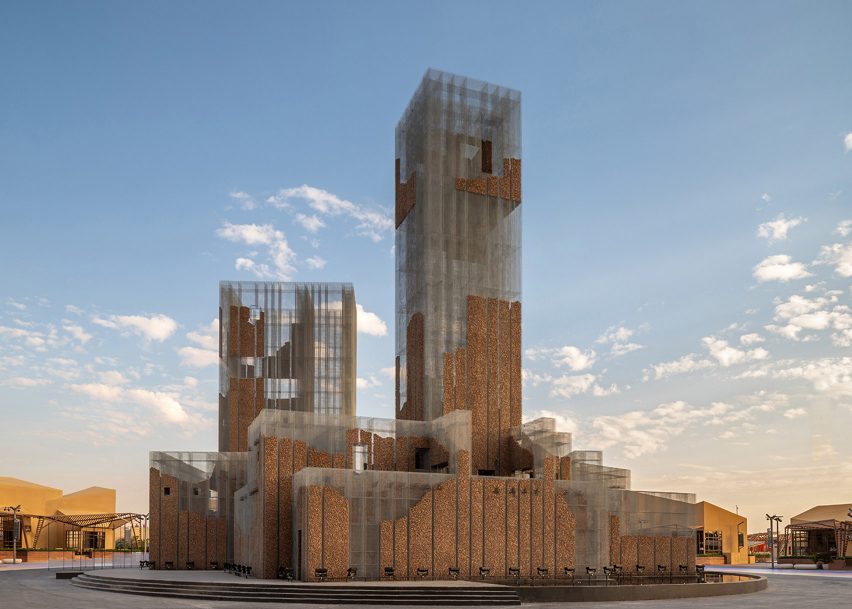Edoardo Tresoldi has combined sound, projections, landscaping and fabric with his signature wire-mesh sculptures for Gharfa, a large site-specific pavilion in Riyadh.
Gharfa is the first project completed by his interdisciplinary lab Studio Studio Studio, in collaboration with artist Alberonero, musician Max Magaldi and garden designer Matteo Foschi of Odd Garden.
Conceived as a theatrical experience, the structure stands 26 metres at its highest point, and is the largest of Tresoldi's ghostly wire-mesh sculptures to date.
Within Gharfa's volumetric, cuboidal arrangement, free-standing cylindrical columns mimic an arcade.
The main entrance is formed by a geometric cut-out with a triangular top, designed as a simplified version of traditional Arabian doorways.
The wire-mesh is partially filled with cork to reflect Diriyah's local mud-brick architecture. Like in his five-metre-tall sculpture Simbiosi, which Tresoldi filled with rocks, the material filling highlights the installation's presence within the landscape.
"The use of the cork expresses a contemporary interpretation of the local ruins," said Studio Studio Studio. "The medium's scenic characteristic is not hidden, but proudly exhibited within a general theatrical approach."
Other aspects of the installation also nod to Riyadh's history and architectural culture. Tresoldi has laid carpet – commonly used as a floor covering in Arabian culture – in one area of the installation beneath a digitally created ceiling of "clouds".
Tresoldi also implements the symmetry characteristically seen in Arabian decor in Foschi's landscape design. Greenery spills equally through the wire mesh walls on opposing sides of the central atrium of the project.
Alberonero, an artist known for his colour-block works and interiors, created a fabric installation called Duna to accompany the monumental wire-mesh outlines.
Semi-transparent fabric walls are supported by a frame of black columns. A video, directed by Tresoldi, depicting fire is projected onto the white fabric.
"[Duna] is right on the threshold of the visible and invisible," said the studio. "It explores space as a place in which one can disappear – stepping away from sight and its tangible perception, creating a subtle limbo that isolates the visitor from the outside world."
Musical segments, created by Magaldi, are played separately in different areas of the Gharfa complex. It is only at the centre where the musical arrangement comes together and can be heard as the full composition.
According to the musician, the visitor is able to "experience their own personal audio mix" as they walk through the installation.
Through contrasting features of digital and analogue, anthropic and natural, and geometric and organic shapes, Studio Studio Studio designed Gharfa as a "combination of reality and illusion".
Gharfa is one of many installations found across Diriyah Oasis, located near UNESCO World Heritage Site At-Turaif.
The installation is part of the Diriyah Oasis project, a festival curated by Designlab Experience that takes place on the outskirts of Saudi Arabia's capital, in the town of Diriyah.
Throughout the month of December every year, it hosts entertainment and events that draw attention to Diriyah's heritage and culture.
The historical district is currently under development to build new museums and cultural buildings. This follows in the footsteps of modernisation happening in Saudi Arabia, including the completion of major architectural landmarks over the coming years.
Photography is by Roberto Conte.

